Grecian Firebolt Strikes Accord
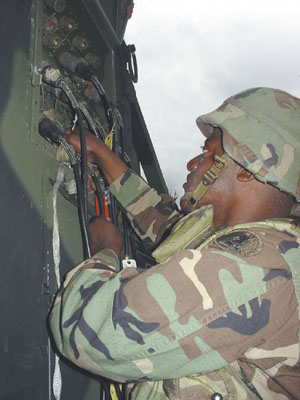 |
| Sgt. 1st Class Lemmon Pitts, USANG, from Company A, Delaware Army National Guard 280th Signal Battalion, checks connections in the signal entrance panel of the single shelter switch during Grecian Firebolt 2005. |
As the military looks to commercial technology to help satisfy its communications needs, U.S. Army reservists working in the private sector are bringing a welcomed source of knowledge to the table. Grecian Firebolt 2005, one of the nation’s largest annual training exercises for Army Reserve communicators, highlighted the ever-closing gap between military know-how and innovative commercial solutions.
And, as more federal and private sector players enter the military operational scene, the effort to connect disparate systems is being embraced by a military now more prone to share information than to cloak it. “This exercise is a way to bring out all the disparate systems and find workarounds,” says Lt. Col. Bernard Smith, USANG, operations chief, 311th Theater Signal Command (TSC),
It also validates the ability of Army reservists to collaborate with real-world players. Many reservists who work in the information technology industry bring their civilian skill set and market knowledge to a military now hungry for commercial off-the-shelf options, Col. Smith says. The 311th TSC and its subordinate units provided command, control, communications and computer support through a theater communications control cell to Grecian Firebolt activities and to five other exercises across the country. They included Golden Medic 05 in
Exercise planners charged the 311th TSC with providing a reliable communications infrastructure to all participating units and agencies. That included five remote detachments from the U.S. Department of Homeland Security’s Federal Emergency Management Agency (FEMA) and a 5,000-volunteer-strong network of military-certified amateur radio operators with the Defense Department-sponsored Military Affiliated Radio System (MARS) program.
To string everyone together, the 311th TSC tested several modes of communication, including very high frequency (VHF); tactical satellite; remote videoconferencing; and voice, data and video over Internet protocol (IP) technology. The exercise validated data, voice and video over IP transmissions, says Maj. Michelle Perry, USAR, the 311th TSC’s exercise officer in charge. She is also a military network engineer. “Voice, video and data are coming together, and everything is IP-based,” she says.
The unit expanded its IP capabilities this year, pushing out beyond TSC to other command units, Maj. Perry explains. The unit’s theater communications control cell programmed network routers with IP addresses to ensure secure nonclassified and Secret communications.
“We tried to run a really tight information assurance section,” she adds. Theater communications control cell network administrators required exercise participants to use password-protected computers and installed a layered network security system to protect data transmission. The network used anomaly detection devices, perimeter and host protection measures, and authentication protocols to keep the network secure.
The exercise allowed players to test new technological capabilities. Soldiers working with MARS representatives linked 311th TSC operations officers with reservists participating in JT 05 in
MARS operators helped fuel realism by pushing 75 percent more scenario-based and real-world messages out to involved agencies and units than during last year’s event, Scoggin notes. Scoggin serves as the emergency operations officer for Eastern Area U.S. Army MARS.
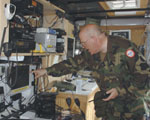 |
| John Scoggin Jr., a U.S. Army Military Affiliate Radio System emergency operations officer, explains the interoperability of the Army MARS equipment used at Fort Meade, Maryland, during the exercise. |
FEMA representatives also injected messages about actual world happenings. Mobile emergency response detachments in five states played out a scenario involving a Category 5 hurricane approaching
“We were receiving real-world traffic during the largest signal exercise in the states,” says Col. Loann Nannini, USAR, chief of staff, 311th TSC. This year, more units participated; more sites were incorporated; and more messages were transmitted, Col. Nannini adds. “We had more of everything.” At least 10 sites participated by sending or receiving voice, data and video messages.
The increased message traffic helped simulate the dynamics of operational communications traffic and unexpected happenings. “There was a tremendous amount of scenario play,” Scoggin says.
Specific sites provided a variety of mediums for connecting various remotely located players. The 311th TSC set up four separate standard tactical entry point, or STEP, sites that tied units into the Defense Information System Network. “We pulled services directly off the STEP sites,” Col. Smith says. Those services included NIPRNET, the secret Internet protocol router network (SIPRNET) and the tactical packet network (TPN). Videoconferencing also played an important role. Through the STEP, Army communicators connected to the Defense Satellite Communication System to send encrypted messages. The 311th TSC control center also maintained continuous, secure, dedicated tactical videoconferencing over SIPRNET to provide connection between the exercise command and remotely located units.
During the exercise, Army participants and their FEMA partners found common ground through the Defense Collaboration Tool Suite, a commercial off-the-shelf-based application providing interoperability to combatant commands, military services and federal agencies. FEMA uses the Defense Department-certified software to integrate with military units and to enable nonclassified and classified communications. “We tried to test interdependency of each element deployed and look at the common denominator of how to gain access to the SIPRNET,”
Defense Collaboration Tool Suite capabilities include desktop voice and videoconferencing, document and application sharing, virtual space, instant messaging and whiteboard functionality. The exercise confirmed that FEMA and Army communicators “are not that far apart in capability,”
As units slated to participate in Grecian Firebolt 2005 dropped out to fulfill real-world missions, Army officials asked FEMA detachments if they could stand in and provide communications support to some participating Army units. “The Army had to constantly re-evaluate who was available to support whom” during the exercise’s planning,
Maj. Perry says the exercise fostered an innovative environment for solving issues that arise in the field. “It’s like backward engineering. You have to find out how things work and look for commonalities,” she says about integrating with different partners. “We didn’t care where you were from. We just took various capabilities and made it work.” Maj. Perry says the exercise encouraged brainstorming, trial and error experimentation, and ingenuity. “Sometimes we had to make the cable connections on site and do things on the fly,” she adds.
The teamwork apparently helped the 311th TSC fulfill its responsibility to provide tactical and strategic networks. Army officials reported a 90 to 95 percent reliability rate for system availability.
Web Resources
Army Military Affiliated Radio Systems: www.asc.army.mil/mars
Federal Emergency Management Agency: www.fema.gov
311th Theater Signal Command: www.usarc.army.mil/311thtsc
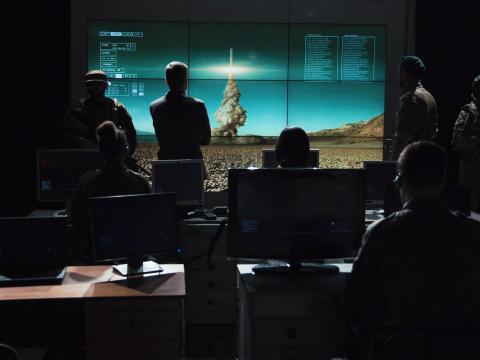
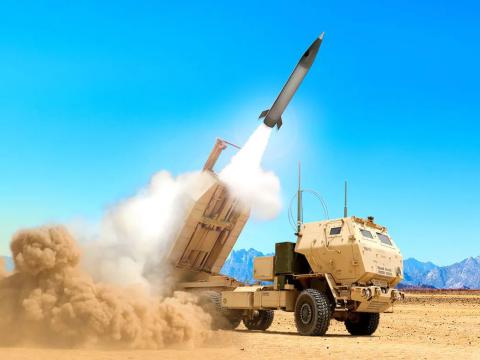
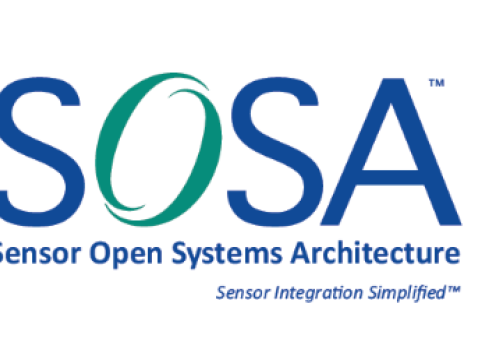

Comments